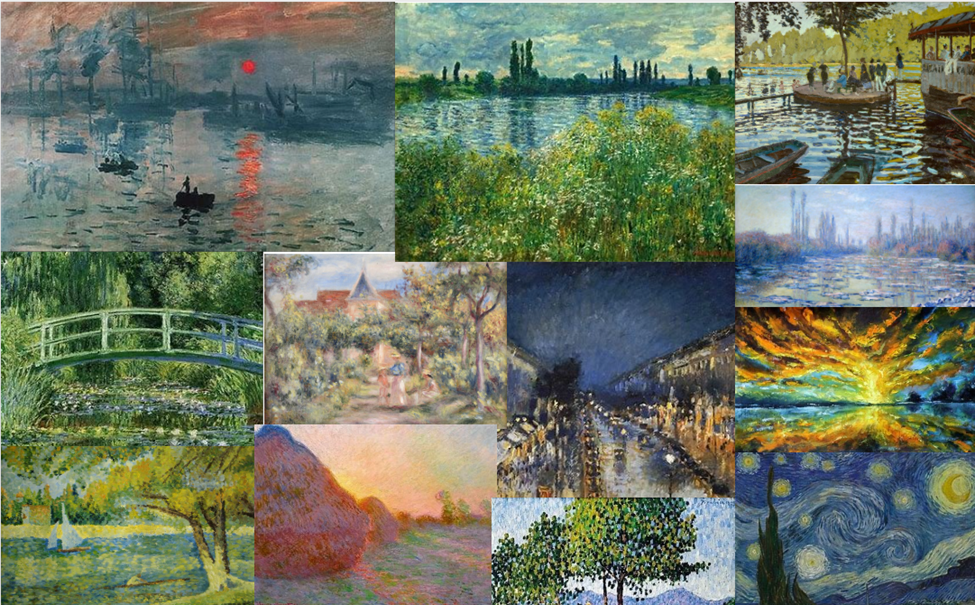“Impressionism is only direct sensation. All great painters were more or less Impressionists. It is mainly a question of instinct.”
What is Impressionism?

Impressionism is a 19th century art movement produced in France, notable by its visible brush strokes and emphasises light. A main characteristic of the work is the bright, colourful paintings normally of nature, like meadows in summer and wildflowers. The movement was considered revolutionary, new to the time period as it captured light, in a completely new way, focusing on its changing element and the colours it created. It began in the late 1860s when artists like Renoir and Monet began to paint landscapes and waterways, adjusting their colour pallet to light, sunny bright colours unlike the previous type of landscape pairing that used muted browns, greens and greys. Completely changing the style, for example in the shadows instead of using blacks and greys they used complementary colours to the rest of the painting, greens and yellows. Perfectly outlined scenes became blurred lines, creating a more abstract look to the style. Compositions became warped into bright, sunny blurs of beautiful landscapes (and further into the movement streets and railroads) completely changing the dark, gloomy landscape style that had been used for years before hand. The movement is also associated with philosophy, specifically the Avanade Garde movement. In simple terms, impressionism looks at the union of human perspective and light, how it changes what it really is.
Impressionism artists
Many of the artists were in their early 20s exploring new techniques, new ideas. Art studios were common practise at the time but as the movement progressed more artists took to painting outside looking at the scene they were capturing. In fact, multiple artists like, Gleyre closed their studios and took to moving to wherever their subject was. Théodore Rousseau was another artist who took inspiration from the Fontainebleau Forest, devoting himself to capturing the reality of the forest in real time, capturing even the mundane details. They were young and tried to capture the ‘impression’ a landscape or person left on them rather than an accurate depiction.
Technique
When it comes to actual technique, the impressionists used bigger brush strokes, less focused on precision and more on the colours. They also used much lighter colours than the previous art, bringing new bright yellows, pinks and greens as their main colours. In leu of having abandoned traditional art techniques they also refused the 3D style much loved by other artists instead wanting to focus on colour and light. Painting an ‘impression’ not a tangible thing. This did lead to many criticisms from other artists, ones with a more traditional manor of painting, saying the slightly abstract appearance was ‘seemingly amateurish quality’ and ‘unfinished in appearance’. Impressionism records the mid century shift in styles in Paris, deciding the new public enjoyment and scenes of the cafes.
Painting outdoors is not specific to Impressionism, but they were the main pioneers for the idea. Claude Monet, the most well known impressionist artist with soft colours, painting multiple times a day to catch different lights and damp paint layers upon damp paint layers to create a deeper abstract look. ‘Plein air’ became common within the impressionist movement, showing the new change in painting, encouraging emotional depth rather than technical prowess within painting.
Impressionism in use outside of painting
Impressionism isn’t just in the art world, it is used as a term through out the world. Music was another big industry with an impressionist movement, influenced by the change in visual arts. Writers like Émile Zola started to try and replicate the emotive, human perception rather than true to life realities of his scenes, similar to the painters. However, while influenced by impressionism the writing style became known as ‘Naturalism’ seeking to convey the emotions and appearance of the world to a certain individual.
Science was progressing in the start of the impressionist era, it was starting to understand that what the eye sees and what the brain understood it as, is different. Leading to the impressionists trying to capture what the eye sees, shapes, colours and more importantly light. This included changes in weather, (Claude Monet painted the same scene multiple times a day to capture the changes) light and colour. The art was not based on what the brain saw but what the eye saw.
